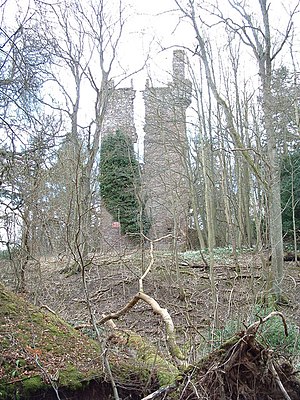Finavon Castle
| Finavon Castle | ||
|---|---|---|
|
Ruin of the residential tower Finavon Castle |
||
| Creation time : | around 1600 | |
| Castle type : | Niederungsburg (Tower House) | |
| Conservation status: | ruin | |
| Standing position : | Scottish nobility | |
| Construction: | Quarry stone | |
| Place: | Milton of Finavon | |
| Geographical location | ||
| Height: | 62 m ASL | |
|
|
||
As Finavon Castle two buildings about 400 meters south of the village of Milton of Finavon and about 8 km northeast of Forfar in the Scottish county of Angus are called. One is the ruin of a residential tower from the beginning of the 17th century and the other is a country house from the 19th century about 130 meters to the west .
history
Since 1375 the site has been owned by Clan Lindsay , the Earls of Crawford . They had the now dilapidated Tower House built. David Lindsay, 10th Earl of Crawford , married Margaret , daughter of Cardinal David Beaton on Finavon , in 1546 .
Their extravagance ruined the Earls of Crawford economically and in 1625 they had to hand over the Barony of Finavon to Alexander Lindsay, 2nd Earl Spynie , to whom they had to sell Finavon Castle. It was passed on to the Carnegie family , the Earls of Aboyne and the Gardynes .
In 1843 Thomas Gardyne bought the castle. Through a marriage in the 18th century, he was also related to the Lindsays who originally owned the property. His descendant, Lieutenant-Colonel Alan David Greenhill Gardyne , died in 1953, leaving the estate to his daughter, Mrs. Susan Mazur .
The Tower House
The Tower House had an L-shaped floor plan, five full floors and an attic and a castle courtyard. The tower that can be seen today dates from around 1600. Excavations have led to the discovery that the tower was an extension to the northeast corner of an older, more extensive complex.
The ruin of the residential tower is a Scheduled Monument .
The cottage
The house was built by the then laird, David Greenhill Gardyne , in 1865 by architects Carver and Symon from Arbroath in the Scottish Baronial Style.
Part of the country house is now used as a holiday home. Historic Scotland has listed the cottage as a Category C Historic Building.
Life in the castle
JB Burke wrote down what life was like at Finavon Castle. He wrote:
“Family life was monotonous but pleasant in character; War exercises, the hunt and the barons' banquet, entertained by the songs of the Ménestrels and the jokes of the court jester, passed the days and the evenings went with chess, at the tables, with reading novels, with playing the bells and bagpipes as well as the harp and with other noble pursuits of great fun and amusement. The ladies mingled everywhere, whether in sport and the festivities in the morning or the pastime in the evening, even if they always spent part of the day in their bedchamber with their girls spinning and weaving tapestries. Occasionally, however, they had to take on more responsibility when the earl was away, whether he was attending a parliamentary session or a war, public or private, his wife became mistress or governor with full authority to rule his vassals, his affairs to regulate and defend his fortress if it was unfortunately attacked in his absence. "
Other nearby attractions
The Finavon Doocot is Scotland's largest pigeon house with 2400 nest boxes. It is said to have been built for the Earl of Crawford in the 16th century and is now maintained by the National Trust .
On Finavon Hill over the castle there is a vitrified Wallburg from the Iron Age . It comes from the middle of the 1st millennium BC. Chr.
On Finavon Castle beat the South Esk you can fly fish for salmon and sea trout.
Individual evidence
- ↑ Finavon Castle . In: Gazetteer for Scotland . Retrieved July 17, 2017.
- ^ A b c W. Douglas Simpson: XV Finavon Castle . Pp. 398-416. 1956. Retrieved July 17, 2017.
- ↑ Scheduled Monument - Entry . In: Historic Scotland .
- ↑ Listed Building - Entry . In: Historic Scotland .
- ↑ JB Burke (editor): The St. James's Magazine and Heraldic and Historical Register . 1850. Retrieved July 17, 2017.
- ↑ Visit Angus: Finavon Doocot . Retrieved on July 17, 2017. ( Page no longer available , search in web archives ) Info: The link was automatically marked as defective. Please check the link according to the instructions and then remove this notice.
- ^ Department of Archeology 45th Annual Report . University of Edinburgh. 1999. Archived from the original on September 20, 2012. Info: The archive link was inserted automatically and has not yet been checked. Please check the original and archive link according to the instructions and then remove this notice. Retrieved November 3, 2012.
swell
- Andrew Jervise: The Land of the Lindsays . David Douglas, Edinburgh 1882.
- Site Reference NO45NE 18 (Old Castle of Finavon) . In: Canmore . Royal Commission on the Ancient and Historical Monuments of Scotland. Retrieved July 17, 2017.


